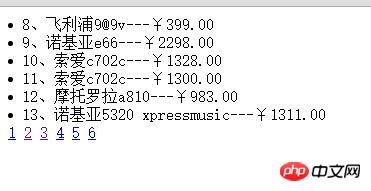A simple implementation of the simplest PHP paging code
php How to paginate This is an introductory tutorial. Let’s talk about the simplest php pagination code. PHP paging code must be used in various program development, and it is a must-select in website development. To write paging code, you must first understand the SQL query statement: select * from goods limit
2,7. The core of the PHP paging code revolves around this statement. The SQL statement explains: Query the goods data table and retrieve 7 pieces of data starting from the 2nd piece of data. In the paging code, 7 represents how many pieces of content are displayed on each page, and 2 represents the number of pages turned through formula calculation. By replacing the value of "2" with different parameters, you can filter out different data.
index.php:
include 'conn.php'; //引入数据库操作类
$conn=new conn(); //实例化数据库操作类
$total=$conn->getOne('select count(*) as total from goods');
$total=$total['total']; //goods表数据总数据条数
$num=6; //每页显示条数
$totalpage=ceil($total/$num); //计算页数
if(isset($_GET['page']) && $_GET['page']<=$totalpage){//这里做了一个判断,若get到数据并且该数据小于总页数情况下才付给当前页参数,否则跳转到第一页
$thispage=$_GET['page'];
}else{
$thispage=1;
}
<BR>//注意下面sql语句中红色部分,通过计算来确定从第几条数据开始取出,当前页数减去1后再乘以每页显示数据条数
$sql='select goods_id,goods_name,shop_price from goods order by goods_id limit '.<SPAN style="COLOR: #ff0000">($thispage-1)*$num</SPAN>.','.$num.'';
$data=$conn->getAll($sql);
foreach($data as $k=>$v){
echo '<li>'.$v['goods_id'].'、'.$v['goods_name'].'---¥'.$v['shop_price'].'</li>';
}
<BR>//显示分页数字列表
for($i=1;$i<=$totalpage;$i++){
echo '<a href="?page='.$i.'">'.$i.'</a> ';
}The above code implements the simplest PHP paging effect:

Only clicks The page turning numbers display different page turning data, which can be further improved on this basis. As long as the basic principles are understood, subsequent work will be easier to develop.
conn.php code:
/*
连接数据库 进行相关查询操作
*/ class conn{ public function __construct(){ include_once('config.php'); try{ $this->pdo = new
PDO('mysql:host=localhost;dbname=test', 'root', '123456');
$this->pdo->setAttribute(PDO::ATTR_ERRMODE, PDO::ERRMODE_EXCEPTION);
$this->pdo->exec('set names utf8');
}
catch(PDOException $e)
{ echo '数据库连接失败:'.$e->getMessage(); exit();
} } //获取一行数据 public function getOne($sql)
{ $rs=$this->pdo->query($sql)->fetch(PDO::FETCH_ASSOC);
return $rs; } //获取多行数据结果 public function getAll($sql)
{ $rs=$this->pdo->query($sql)->fetchall(PDO::FETCH_ASSOC); return $rs; }
}The function of conn.php is to complete the database connection and implement the data extraction operation method. Here I use pdo, and the code can be organized according to everyone's habits.
config.php:
/*配置数据库信息 */ $cfg_dbhost='localhost'; $cfg_dbname='test'; $cfg_dbuser='root'; $cfg_dbpw='123456';
This example is only to illustrate the basic paging principle. There are still many modifications before actual use. Hope this example can help everyone.
Related recommendations:
A universal php paging class instance code
php paging instance code (can be modified directly Use)
Recommended php paging query example tutorial
php paging class code sharing: the latest 10 in 2017 PHP paging class code download
The above is the detailed content of A simple implementation of the simplest PHP paging code. For more information, please follow other related articles on the PHP Chinese website!

Hot AI Tools

Undresser.AI Undress
AI-powered app for creating realistic nude photos

AI Clothes Remover
Online AI tool for removing clothes from photos.

Undress AI Tool
Undress images for free

Clothoff.io
AI clothes remover

AI Hentai Generator
Generate AI Hentai for free.

Hot Article

Hot Tools

Notepad++7.3.1
Easy-to-use and free code editor

SublimeText3 Chinese version
Chinese version, very easy to use

Zend Studio 13.0.1
Powerful PHP integrated development environment

Dreamweaver CS6
Visual web development tools

SublimeText3 Mac version
God-level code editing software (SublimeText3)

Hot Topics
 CakePHP Project Configuration
Sep 10, 2024 pm 05:25 PM
CakePHP Project Configuration
Sep 10, 2024 pm 05:25 PM
In this chapter, we will understand the Environment Variables, General Configuration, Database Configuration and Email Configuration in CakePHP.
 PHP 8.4 Installation and Upgrade guide for Ubuntu and Debian
Dec 24, 2024 pm 04:42 PM
PHP 8.4 Installation and Upgrade guide for Ubuntu and Debian
Dec 24, 2024 pm 04:42 PM
PHP 8.4 brings several new features, security improvements, and performance improvements with healthy amounts of feature deprecations and removals. This guide explains how to install PHP 8.4 or upgrade to PHP 8.4 on Ubuntu, Debian, or their derivati
 CakePHP Date and Time
Sep 10, 2024 pm 05:27 PM
CakePHP Date and Time
Sep 10, 2024 pm 05:27 PM
To work with date and time in cakephp4, we are going to make use of the available FrozenTime class.
 CakePHP File upload
Sep 10, 2024 pm 05:27 PM
CakePHP File upload
Sep 10, 2024 pm 05:27 PM
To work on file upload we are going to use the form helper. Here, is an example for file upload.
 CakePHP Routing
Sep 10, 2024 pm 05:25 PM
CakePHP Routing
Sep 10, 2024 pm 05:25 PM
In this chapter, we are going to learn the following topics related to routing ?
 Discuss CakePHP
Sep 10, 2024 pm 05:28 PM
Discuss CakePHP
Sep 10, 2024 pm 05:28 PM
CakePHP is an open-source framework for PHP. It is intended to make developing, deploying and maintaining applications much easier. CakePHP is based on a MVC-like architecture that is both powerful and easy to grasp. Models, Views, and Controllers gu
 CakePHP Creating Validators
Sep 10, 2024 pm 05:26 PM
CakePHP Creating Validators
Sep 10, 2024 pm 05:26 PM
Validator can be created by adding the following two lines in the controller.
 CakePHP Working with Database
Sep 10, 2024 pm 05:25 PM
CakePHP Working with Database
Sep 10, 2024 pm 05:25 PM
Working with database in CakePHP is very easy. We will understand the CRUD (Create, Read, Update, Delete) operations in this chapter.






